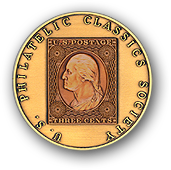Please click a value for in-depth detail.

STATISTICS
Issued: The 4¢ was officially issued on January, 1st 1893, a Sunday, and at Post Offices the following day. There are a couple of examples postmarked, one in Boston and one inNew York, N.Y., on January 1st, 1893.

Plate Size: Sheets of 100 subjects (2 panes of 50).

Printer: The American Bank Note Company.
Watermark: None.
Quantity Issued: 19,181,550.
Color: Ultramarine, dull ultramarine or deep ultramarine. Two sheets were printed in the deep blue used to print the 1¢ Columbian, a color error that commands high prices in today’s market. Two sheets of the deep blue error color, #D17 and #D18, were purchased whole, the plate numbers from these sheets still exist.

Common use: The stamp often paid the double weight, first-class mail rate. It was also frequently used, in combination with other stamps, to pay for foreign destination rates.


THE INSPIRATION FOR THE DESIGN
The vignette depicts the Fleet of Columbus, the flagship of Christopher Columbus, the Santa Maria is prominent in the center. The origin of the image is Gustav Adolf Closs’s 1892 painting “Die Schiffe des Columbus” (The ships of Columbus).

VARIETIES
A fairly common variety is the “Three Leaf” variety, caused by a flaw in the plate above the two leafs adjacent to the right positioned figure 4 on the design.

ESSAYS AND PROOFS
Despite the popularity of the Columbian series there are very few essays and proofs on the market, the most common of which is the 4¢ value.


- Brookman, Lester G., U.S. Postage Stamps of the 19th Century, Lindquist 1966
 .com
.comThe Swedish Tiger’s US Stamp Site An Illustrated Guide
Please click a value for in-depth detail.

